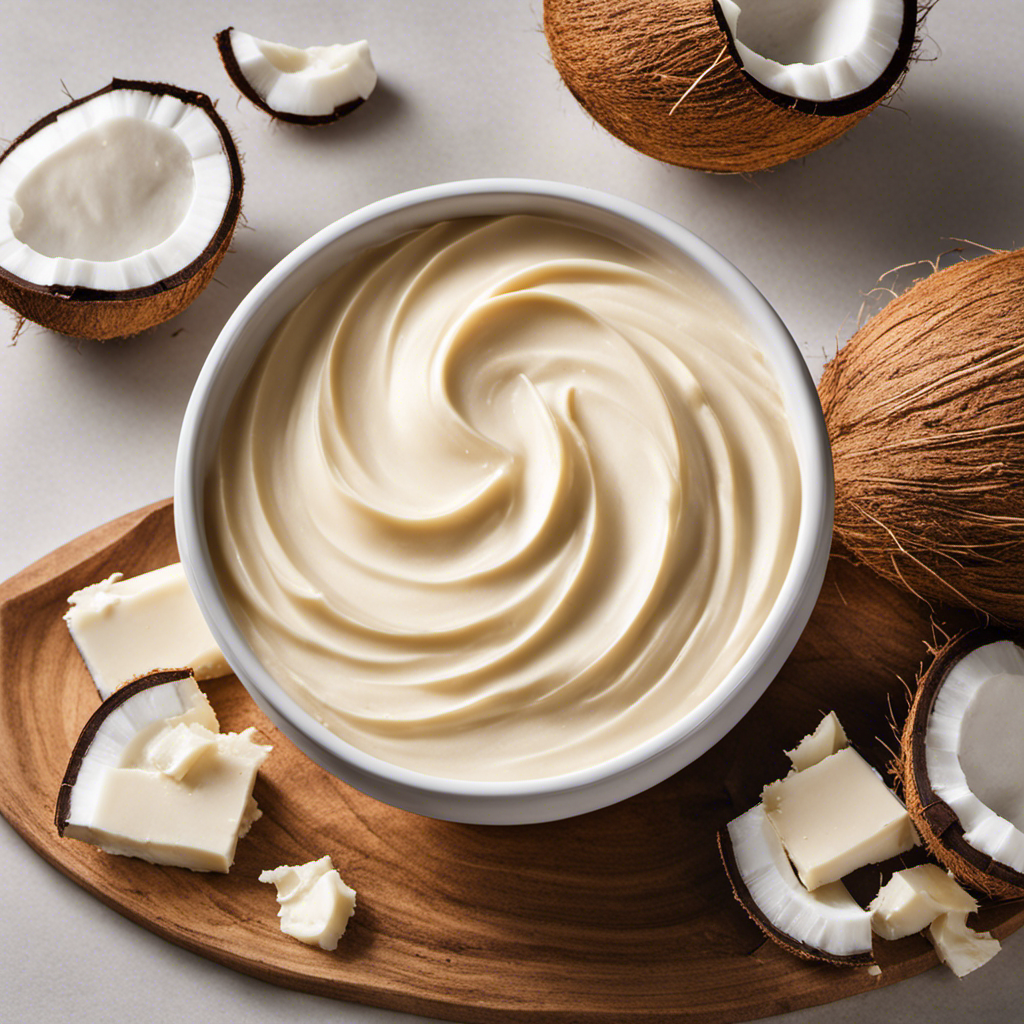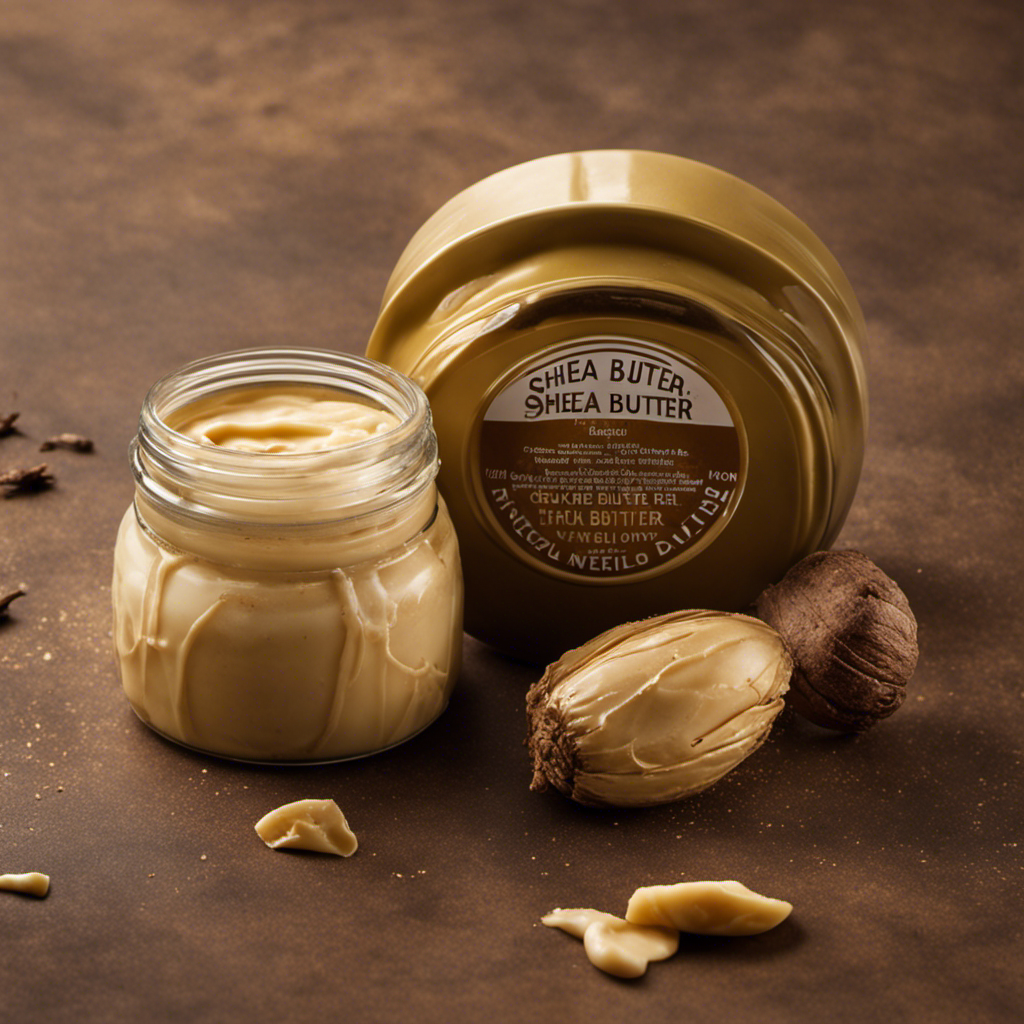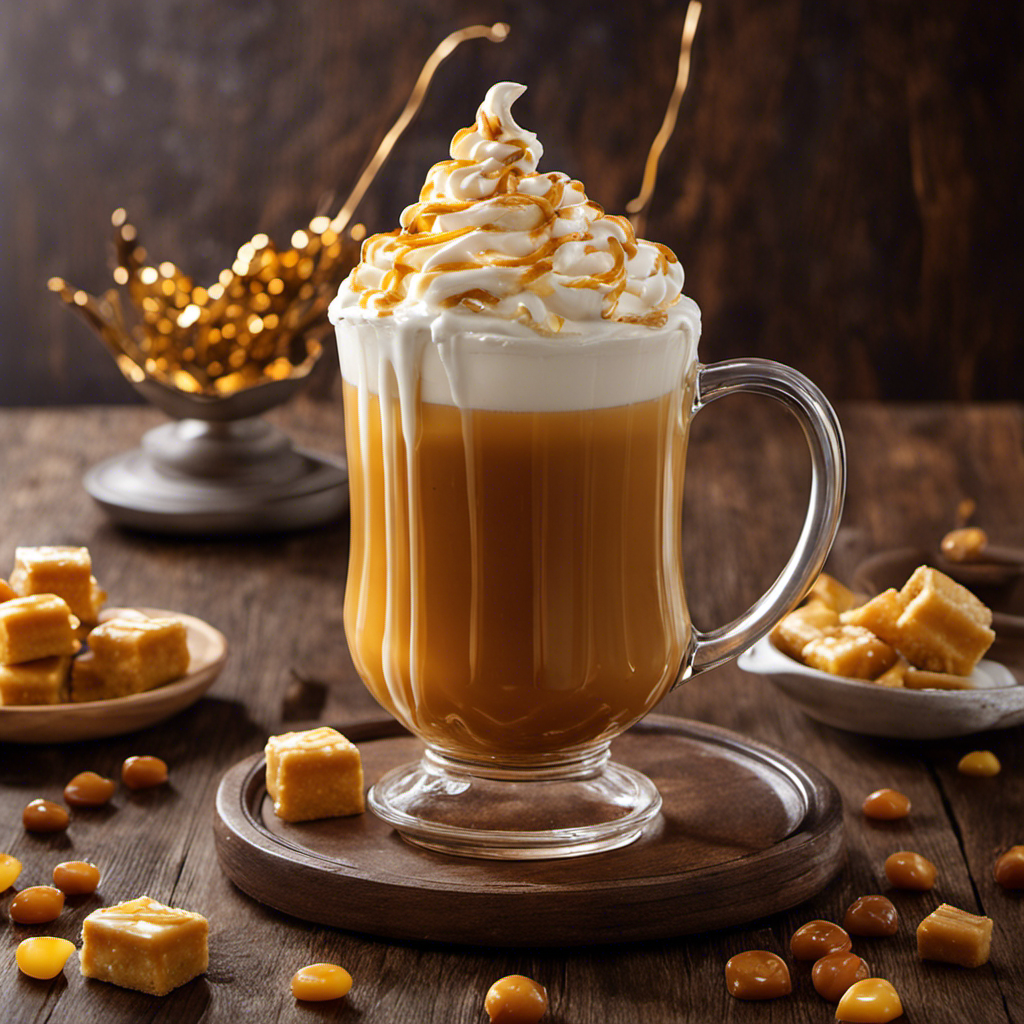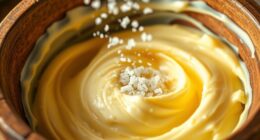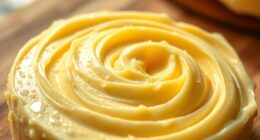As a lover of nutritious and wholesome foods, I am constantly on the lookout for delicious and versatile ingredients. Let me tell you, fresh butter beans are a true gem in the culinary world.
These creamy legumes, with their smooth texture and delicate flavor, can elevate any dish to new heights. Whether you’re a seasoned cook or a novice in the kitchen, this article will guide you through the art of preparing and cooking fresh butter beans, unlocking a world of delectable possibilities.
So grab your apron and let’s dive into the wonderful world of butter beans!
Key Takeaways
- Look for plump and blemish-free beans
- Soak the beans in cold water for at least 4 hours or overnight
- The cooking method for butter beans depends on preference and recipe
- Soaking the beans enhances digestibility, reduces cooking time, improves flavor and texture, and enhances nutrient absorption.
Choosing and Preparing Fresh Butter Beans
When choosing fresh butter beans, it’s important to look for ones that are plump and free of blemishes. These beans come in a beautiful range of colors, from pale cream to vibrant green.
To ensure their tenderness and flavor, fresh butter beans require soaking before cooking. Soak them in cold water for at least 4 hours or overnight. This helps to soften the beans and reduce their cooking time.
Once soaked, there are various cooking methods you can use to bring out the best in these delicious legumes. You can boil them until tender, sauté them with garlic and herbs, or even bake them with a savory sauce. The choice of cooking method depends on your preference and the recipe you’re following.
Soaking Butter Beans for Optimal Cooking
Soaking butter beans before cooking is a crucial step in achieving the perfect texture and flavor. The soaking time can vary depending on the size and freshness of the beans, but generally, overnight soaking is recommended.
This process helps to soften the beans, reduce cooking time, and improve their digestibility, allowing you to fully enjoy their creamy goodness.
Soaking Time for Beans
The recommended soaking time for fresh butter beans is usually around 8-12 hours. Soaking beans overnight has numerous benefits. Firstly, it helps to soften the beans, making them easier to cook and reducing the cooking time. Secondly, it helps to remove some of the natural sugars in the beans, which can cause digestive discomfort for some people. By soaking the beans, these sugars are released into the soaking water, resulting in a more easily digestible final dish. However, if you don’t have time for overnight soaking, there are alternative methods you can try. One option is to use the quick soak method, where you bring the beans to a boil, remove from heat, and let them sit for an hour. Another option is to use a pressure cooker, which can cook the beans without soaking in a fraction of the time. Overall, soaking fresh butter beans is key to achieving the best texture and flavor in your dishes.
| Benefits of Overnight Soaking | Alternative Methods of Cooking Beans |
|---|---|
| Softens the beans | Quick soak method |
| Reduces cooking time | Pressure cooker |
| Removes natural sugars |
Benefits of Soaking
Using the quick soak method or a pressure cooker can save time when preparing beans. As someone who loves cooking, I have discovered the benefits of overnight soaking and alternative soaking methods. Here are some reasons why you should consider these methods:
-
Enhanced Digestibility: Soaking beans overnight or using alternative methods helps break down complex sugars and starches, making them easier to digest.
-
Reduced Cooking Time: By soaking beans, you can significantly reduce their cooking time, saving you precious minutes in the kitchen.
-
Improved Flavor and Texture: Soaking beans overnight allows them to absorb water, resulting in a creamier texture and more robust flavor.
-
Enhanced Nutrient Absorption: Soaking beans enhances their nutrient availability, allowing your body to absorb more vitamins and minerals.
Incorporating these soaking methods can elevate your butter bean dishes to a whole new level, providing you with delicious and nutritious meals in no time.
Boiling Butter Beans: Step-By-Step Instructions
To cook fresh butter beans, start by rinsing them under cold water to remove any dirt or impurities. Then, bring a pot of water to a boil and add the beans. The boiling time will depend on the size and freshness of the beans, but it usually takes around 25-30 minutes. While they’re boiling, you can add flavorings like salt, pepper, garlic, or herbs to enhance their taste. The beans will become tender and creamy when they’re ready.
Once cooked, drain them and they’re ready to be enjoyed in various dishes.
Now that you know how to boil butter beans, let’s move on to the next step: slow-cooking them for added flavor.
Slow-Cooking Butter Beans for Added Flavor
When it comes to slow-cooking butter beans, I’ve learned that seasoning is the key to achieving maximum flavor. By adding a combination of herbs and spices like thyme, garlic, and smoked paprika, you can elevate the taste of your dish to a whole new level.
Additionally, it’s important to consider cooking time recommendations as overcooking can result in mushy beans, while undercooking may leave them too firm. By finding the perfect balance, you’ll be rewarded with butter beans that are tender, flavorful, and absolutely delicious.
Seasoning for Maximum Flavor
For maximum flavor, it’s important to season fresh butter beans with a blend of herbs and spices. Seasoning your beans properly can elevate their taste and make them even more delicious. Here are some different types of seasonings and the proper technique for seasoning your butter beans:
- Garlic powder: adds a savory and slightly spicy flavor.
- Onion powder: provides a sweet and aromatic taste.
- Paprika: adds a smoky and slightly sweet flavor.
- Thyme: adds a subtle earthy and herby taste.
To season your butter beans, simply sprinkle a pinch of each seasoning onto the beans and mix well. Make sure to taste and adjust the seasonings according to your preference. The combination of these herbs and spices will enhance the natural flavors of the butter beans, creating a mouthwatering dish.
Now that your butter beans are seasoned to perfection, let’s move on to the next step: cooking time recommendations.
Cooking Time Recommendations
Now that they’re seasoned, you’ll want to simmer the butter beans for about 45 minutes to ensure they’re cooked to perfection.
But before we get into the cooking time, let’s talk about soaking techniques. Soaking butter beans overnight in water with a pinch of salt can help soften them and reduce cooking time. However, if you’re short on time, you can also use a quick-soak method. Simply bring the beans to a boil in a pot of water, remove from heat, and let them sit for an hour.
Now, let’s move on to alternative cooking methods. While simmering is the most common method, you can also pressure cook butter beans for faster results or even try slow cooking them for a richer flavor.
Whichever method you choose, remember to taste a bean for desired tenderness before serving.
Pressure Cooking Butter Beans: a Quick and Easy Method
To save time and effort, you can use a pressure cooker to quickly and easily cook fresh butter beans. Pressure cooking is a great alternative to slow cooking because it reduces cooking time significantly and helps retain the nutrients in the beans. Here are some pros and cons of pressure cooking:
Pros:
- Faster cooking time
- Preserves nutrients
- Tenderizes beans quickly
- Energy efficient
Cons:
- Risk of overcooking if not monitored closely
- Limited capacity for larger batches
- Requires some learning and practice
- Less control over cooking process
When pressure cooking butter beans, make sure to soak them beforehand and add enough liquid to the cooker. Set the pressure and cooking time according to your preference. Once cooked, release the pressure carefully and enjoy your delicious butter beans in no time!
Sautéing Butter Beans With Herbs and Spices
Sauteed butter beans with herbs and spices create a flavorful and aromatic side dish. This cooking method brings out the natural sweetness of the beans while adding layers of delicious flavors.
To sauté butter beans, start by heating some olive oil in a pan over medium-high heat. Add the beans and cook them until they are golden brown and slightly crispy, about 5-7 minutes.
Next, add your choice of herbs and spices such as garlic, thyme, and paprika to elevate the taste. The sautéing technique allows the beans to absorb the flavors, resulting in a mouthwatering dish. You can experiment with different flavor combinations like lemon zest and parsley or cumin and coriander for a unique twist.
Sautéed butter beans make a perfect side dish for any meal, adding a burst of flavor and a healthy dose of protein.
Now, let’s discover another cooking method that will give these beans a crispy texture: roasting.
Roasting Butter Beans for a Crispy Texture
When it comes to roasting butter beans, there are several benefits that make it worth trying.
Firstly, the roasting process gives the beans a deliciously crispy texture that is hard to resist.
Secondly, roasting allows for endless seasoning options, from simple salt and pepper to a variety of herbs and spices that can elevate the flavor to a whole new level.
Lastly, it’s important to keep in mind the cooking time and temperature to ensure the beans are cooked through and golden brown on the outside.
Benefits of Roasting
You can enhance the flavor and texture of fresh butter beans by roasting them in the oven. Roasting brings out the natural sweetness of the beans and gives them a satisfying crunch.
Here are some benefits of roasting and different methods you can try:
-
High heat: Roasting at a high temperature helps to caramelize the sugars in the beans, resulting in a rich, nutty flavor.
-
Dry roasting: This method involves tossing the beans with olive oil, salt, and any desired spices, then roasting them in a preheated oven until they are crispy and golden brown.
-
Pan roasting: Heat a skillet over medium-high heat, add the beans and a little oil, and cook until they are tender and slightly charred.
-
Air frying: For a healthier option, try roasting the beans in an air fryer. This method requires less oil and still produces crispy results.
Roasting butter beans is a simple and delicious way to elevate their taste and texture. Give it a try and enjoy the delightful flavors that come from roasting!
Seasoning Options for Roasting
Roasting is a versatile cooking method that allows for a variety of seasoning options to enhance the flavor of your dish. When it comes to roasting, there are endless possibilities for flavor combinations. Whether you prefer sweet or savory, there’s a seasoning option to suit every taste.
For a classic roasted chicken, try a combination of garlic, thyme, and lemon zest. If you’re looking for something with a little kick, a mix of paprika, cayenne pepper, and cumin will add a bold and spicy flavor to your meat or vegetables. For a more exotic twist, try a blend of coriander, turmeric, and ginger.
The key to successful roasting is experimenting with different roasting techniques and finding the perfect flavor combination that suits your palate. Now that we’ve explored the seasoning options, let’s move on to the next crucial aspect of roasting: cooking time and temperature.
Cooking Time and Temperature
To ensure your meat is cooked to perfection, it’s important to monitor the internal temperature and adjust the cooking time accordingly. Here are some key points to keep in mind when it comes to cooking time and temperature:
- Use a meat thermometer to accurately gauge the internal temperature of your meat.
- Different cooking techniques require different temperatures. For example, grilling requires high heat, while slow cooking requires low heat.
- Adjust the cooking time based on the thickness and size of your meat. Thicker cuts will require longer cooking times.
- Experiment with alternative cooking methods like sous vide or smoking to achieve different flavors and textures.
By understanding the importance of cooking time and temperature, you can elevate your cooking techniques and explore alternative methods for preparing delicious meals.
Now, let’s transition into the next section about steaming butter beans: a healthy cooking option.
Steaming Butter Beans: a Healthy Cooking Option
For a healthier cooking option, try steaming your fresh butter beans until they are tender and delicious. Steaming is a fantastic way to preserve the natural flavors and textures of the beans while also retaining their nutritional value.
Not only does steaming help to maintain the vibrant green color of the beans, but it also ensures that they are cooked evenly and retain their firmness. This cooking method is ideal for those looking to reduce their intake of added fats and oils, as no additional oil is needed.
Steamed butter beans are packed with health benefits, including being a great source of dietary fiber, protein, and essential minerals. By steaming them, you can enjoy all the goodness of butter beans without compromising on taste or nutrition.
Making Butter Bean Soup: a Comforting Dish
After steaming butter beans, I decided to try another delicious dish using these versatile legumes. So, I decided to make a comforting butter bean soup. Let me tell you, the result was absolutely amazing! The creamy texture of the beans combined with the flavorful broth created a hearty and satisfying soup that warmed my soul.
If you’re looking for new ways to enjoy butter beans, here are a few ideas:
- Butter bean casserole: A cheesy and flavorful dish that pairs perfectly with a side of crusty bread.
- Butter bean hummus: A twist on traditional hummus using butter beans for a creamy and smooth dip.
- Butter bean and vegetable stir-fry: A quick and healthy option that combines the earthy flavor of butter beans with fresh vegetables.
- Butter bean and potato salad: A refreshing and filling salad that makes a great side dish for any meal.
Now, let’s move on to incorporating butter beans into salads and side dishes.
Incorporating Butter Beans Into Salads and Side Dishes
Incorporating butter beans into salads and side dishes adds a delicious and nutritious twist to your meals.
One of my favorite ways to enjoy butter beans is in a butter bean and quinoa salad. The creamy texture of the beans pairs perfectly with the nutty flavor of quinoa. I love to add some fresh vegetables like cherry tomatoes, cucumbers, and bell peppers for a burst of color and crunch. The combination of flavors is simply divine.
Another fantastic option is a butter bean and vegetable stir fry. Saute some onions, garlic, and your favorite veggies in a hot pan, then add in the butter beans for an extra protein boost. The beans soak up all the flavors, creating a mouthwatering dish that is both satisfying and healthy.
Storing and Freezing Fresh Butter Beans for Future Use
To properly store and freeze fresh butter beans for future use, you’ll need to blanch them first. Blanching helps preserve the color, texture, and nutritional value of the beans.
Here’s a step-by-step guide on how to freeze butter beans:
- Start by washing the beans thoroughly and removing any dirt or debris.
- Bring a pot of water to a boil and add the beans. Cook them for 2-3 minutes until they are slightly tender.
- Once cooked, transfer the beans to an ice bath to stop the cooking process and cool them down quickly.
- Drain the beans and pat them dry with a paper towel.
- Place them in a freezer-safe bag or container and label it with the date.
Frequently Asked Questions
Can I Use Canned Butter Beans Instead of Fresh Ones in These Recipes?
I prefer using fresh butter beans instead of canned ones in these recipes. Fresh butter beans have a better texture and flavor, and they retain more nutrients. Plus, cooking with fresh ingredients always adds a special touch to any dish.
How Long Does It Take to Slow-Cook Butter Beans for Added Flavor?
Slow cooking butter beans for added flavor takes approximately 2-3 hours. The extended cooking time allows the beans to absorb the flavors of the seasonings and become tender and creamy.
Can I Use Dried Butter Beans Instead of Fresh Ones?
Yes, you can use dried butter beans instead of fresh ones in recipes. However, there are some nutritional differences between the two. Dried beans may require soaking and longer cooking times to achieve desired tenderness and flavor.
What Are Some Recommended Herbs and Spices to Sauté Butter Beans With?
When it comes to enhancing the flavor of butter beans, I love using a combination of fresh herbs and spices. Some recommended options include garlic, thyme, and paprika for a flavorful sauté.
How Long Can I Store Fresh Butter Beans in the Refrigerator Before They Go Bad?
I usually store fresh butter beans in the refrigerator for about 3-5 days before they start to go bad. Signs of spoiled butter beans include a slimy texture, unpleasant odor, and discoloration.
Conclusion
In conclusion, I must say that cooking fresh butter beans is truly a delightful experience.
From selecting the perfect beans to preparing them with love, it’s a journey that results in delicious and nutritious meals.
Did you know that butter beans are not only tasty but also packed with fiber? In fact, just one cup of cooked butter beans provides a whopping 17 grams of fiber!
So next time you cook up a batch of these creamy delights, remember that you’re not just treating your taste buds, but also taking care of your digestive health.
Happy cooking!


